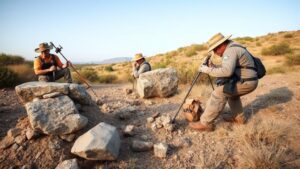The Discovery of the Ringlemere Cup: Metal Detecting Uncovers a Rare Bronze Age Gold Vessel in the UK
The Discovery of the Ringlemere Cup: Metal Detecting Uncovers a Rare Bronze Age Gold Vessel in the UK
The Ringlemere Cup, a stunning Bronze Age gold vessel, was discovered in Kent, United Kingdom, in 2004 by a metal detector enthusiast named Derek McLennan. This remarkable find has significantly enriched our understanding of prehistoric societies in Britain and has sparked interest in the role of metal detecting in archaeological discoveries. This article delves into the discovery process, the significance of the cup, and the broader implications for archaeology and heritage management.
The Discovery
The Ringlemere Cup was discovered in a field near the Ringlemere Barrow, a site with known archaeological significance. McLennan’s metal detector indicated a strong signal approximately 15 inches beneath the surface. Upon excavation, he unearthed the cup–an exquisitely crafted vessel made of gold, adorned with intricate designs that exemplify the artistry of the Bronze Age.
This find is particularly significant not just for its material value, but also for its connection to burial practices and social hierarchies during the Bronze Age. The cup is believed to date back to around 2300-2100 BCE, making it over 4,000 years old. Such a long-standing artifact provides invaluable insights into the beliefs and customs of early Britons.
The Ringlemere Cup is significant for several reasons:
- Cultural Insight: The cup serves as a tangible link to the past, shedding light on the ceremonial practices of Bronze Age societies. Its elaborate design suggests that it may have been used in burial rites or other significant communal events.
- Technological Advancement: The craftsmanship of the Ringlemere Cup exemplifies advanced metalworking techniques for its time. The ability to create such precise designs illustrates a high level of skill and technological development among contemporary artisans.
- Social Structure: The richness of the materials and artistry indicates that the individual buried with the cup was likely of high status, thus providing clues about social hierarchies in prehistoric communities.
Implications for Archaeology and Metal Detecting
The discovery of the Ringlemere Cup has initiated discussions about the role of metal detecting in archaeology. While metal detecting can often be viewed with skepticism–due to concerns about treasure hunting versus scholarly excavation–the Ringlemere find underscores the potential benefits of responsible detecting under proper guidelines.
Metal detectorists can act as allies to archaeologists, locating significant artifacts that might otherwise remain undiscovered. But, it is crucial for detectorists to adhere to ethical guidelines, including:
- Reporting finds to local archaeological authorities
- Understanding what constitutes legally protected artifacts
- Engaging in respectful interactions with the land, ensuring minimal disturbance to historical sites
In the case of the Ringlemere Cup, the story concluded positively, leading to its inclusion in the British Museum’s collection, where it can be preserved and studied further. This case presents a model for future collaborations between hobbyists and professional archaeologists.
Case Studies and Broader Context
The discovery of the Ringlemere Cup is not an isolated incident in the realm of metal detecting; rather, it is part of a broader narrative involving several significant discoveries across the UK. For example, the Staffordshire Hoard, uncovered in 2009, is regarded as the largest hoard of Anglo-Saxon gold and silver ever found, further demonstrating the potential for amateur metal detection to influence historical scholarship.
Similarly, the recent discovery of a Roman villa in Somerset by a detectorist exemplifies the ongoing contributions of enthusiasts to archaeological knowledge. Such finds not only enrich local history but also emphasize the collaborative spirit between professional archaeologists and engaged citizens.
Actionable Takeaways
Here are some actionable takeaways regarding the implications of the Ringlemere Cup’s discovery:
- Encourage a partnership model between archaeologists and metal detectorists to enhance historical research.
- Promote educational programs focused on responsible detecting and artefact stewardship.
- Support archaeological licensing laws that align with the interests of metal detecting communities.
To wrap up, the discovery of the Ringlemere Cup signifies much more than the unearthing of a golden artifact; it stands as a testament to the intricate societal structures of the Bronze Age and the potential for modern methods, such as metal detecting, to contribute meaningfully to our understanding of human history. As we continue to explore and protect our archaeological heritage, collaborative efforts will be instrumental in ensuring that future finds are preserved and appreciated for generations to come.



